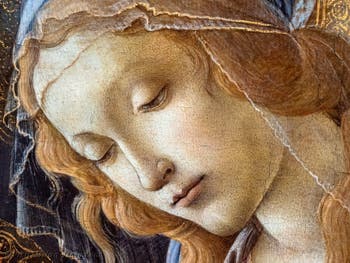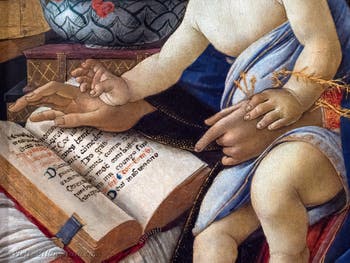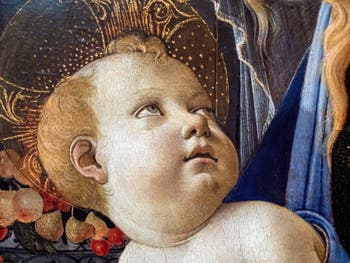Museums Ambrosiana | Castello Sforzesco | Poldi Pezzoli
Poldi Pezzoli Artists | Location | Opening Hours Tickets | Authorizations
Artists Bellini | Botticelli | Canaletto | Carriera | Cranach | Daddi | Francesca | Giordano | Guardi | Lippi F. | Lotto | Luini | Mantegna | Montagna | Memling | Palma | Pinturicchio | Pollaiolo | Raphael | Tiepolo | Titian | Weapons Room
Botticelli “Madona of the Book - Virgin and Child” Poldi Pezzoli Museum in Milan in Italy
Botticelli (1st March 1445 - 17 May 1510) “Madona of the Book - Virgin and Child”
Painting - Tempera on wood (58 x 39.6 cm) 1480-1481
Madona of the Book This beautiful painting by Botticelli, full of tenderness and sweetness, shows the Infant Jesus sitting on his mother's lap, his face turned towards her.
Mary holds it close with one hand while her other hand prepares to turn the page of a book of hours, one of those daily prayer books that were in use between the 13th and 16th centuries.
Jesus looks up at her like a child, expressing his request for motherly tenderness.
Mary's attitude, the way she holds her Child, her hands, and her corporal expression perfectly reflect her love as a mother, at the same time as her melancholy and her presentiment of the tragic destiny that awaits Jesus.
The face and body of Our Lady show all her resignation.
A mother must protect her Child, but Marie has already lost all hope in this regard; she expresses the pain of her helplessness by letting her head lean forward and seems to have lost the strength to hold it back, her eyes are half-closed, her mouth is closed as if she no longer even felt the need to speak.

Madona of the Book She knows that this Child is divine, that he is on earth for a divine mission, and that she is only there to help him fulfil it.
She feels that she has already lost and has no point in trying to fight to protect her son; she can only accompany him with her love.
Madonna and Child are already linked, united spiritually in the tragic destiny that awaits Jesus. The way Botticelli positioned the bodies of Jesus and Mary unites them together.
This unity of composition is also used to show the purity of their relationship.
A divine purity that is also expressed in the lights of the painting.

Madona of the Book A window opening behind Marie illuminates the room where they are, but this outside light does not touch their faces.
These two beings with halos are the source of pure light much more potent than that coming from the window; a divine light emanates from the face of the Virgin and the whole body of Christ.
The blue fabric wrapped around the body of Jesus seems to be an extension of Madonna's turban that runs down her shoulder to end up wrapping the divine Child with the same colour and texture, producing the same folds.

Madona of the Book They are thus connected to each other.
The hands of Jesus are gently and tenderly placed on those of his mother.
Faced with the dismay expressed by Mary, the Infant Jesus seems innocent of what troubles his mother.
However, his eyes raised towards her express his love and compassion for what she will have to endure and suffer because of him.

Madona of the Book You will notice that Jesus is holding three gold nails in his hand and that a crown of thorns surrounds his arm.
But these symbols of the Passion of Christ have been added to the painting and are not from Botticelli's hand.
Botticelli, however, sprinkled his painting with numerous other symbols.
First, the elegant dark blue mantle of the Madonna, with its radiant gold star, refers to the sky and the star, followed by the Three Wise Men who came to bring their gifts to the newborn divine Child.
The fruit bowl is also rich in symbols.
Cherries refer to the blood of Christ; light plums, a symbol of fidelity, refer to the tenderness between mother and Child; and figs symbolize Salvation and Resurrection.
Artists Bellini | Botticelli | Canaletto | Carriera | Cranach | Daddi | Francesca | Giordano | Guardi | Lippi F. | Lotto | Luini | Mantegna | Montagna | Memling | Palma | Pinturicchio | Pollaiolo | Raphael | Tiepolo | Titian | Weapons Room
Poldi Pezzoli Artists | Location | Opening Hours Tickets | Authorizations
Museums Ambrosiana | Castello Sforzesco | Poldi Pezzoli
Back to Top of Page










